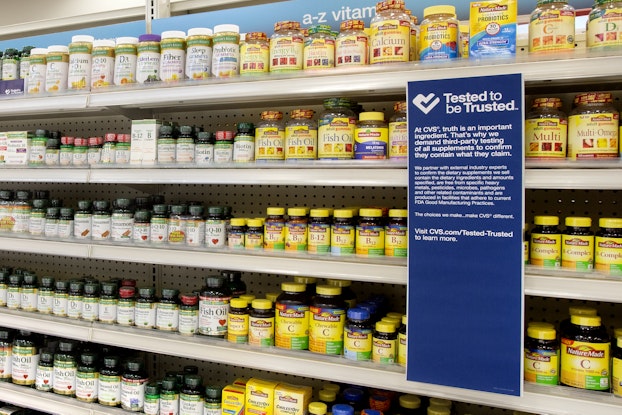
A redesign in the works at CVS Pharmacy reveres the time-honored maxim: It matters not just what you say, but how you say it.
Coming this year to more than 9,000 retail locations is a makeover of in-store messaging that harmonizes how CVS and its brands communicate with consumers, informed by shopper intent — whether they’re picking up prescriptions or paper towels.
The store signage optimization program is the latest in a series of moves by the drugstore behemoth to secure customer loyalty as a trusted partner in good health, said Marcy Brewington, director, in-store marketing strategy, CVS Health, during her presentation at November’s Path to Purchase (P2PX) conference in Chicago.
It comes as marketers, scrambling to redefine convenience for consumers who can get everything and anything online, test ways to personalize the purchasing journey, including via in-store messaging that speaks to shoppers’ micro-moment needs.
Indeed, with “micronarratives,” marketers are crafting a brand story that captures a customer at a given moment in which they have specific wants, and serves up messages that reveal one way to fulfill those wants, according to Gartner. “When brands use stories well, they reveal an alternative future for the customer in which they are able to ‘Think Different’ (Apple) or to meet ‘The Man Your Man Could Smell Like’ (Old Spice). For brand stories to connect with customers and help them progress through the buying funnel, marketers need both relevance and consistency across product lines and channels.”
Earlier efforts by CVS to instill trust by focusing on wellness and transparency include its bold and costly exit from tobacco sales; $70 billion acquisition of Aetna; and 600 new HealthHUBs rolling out as a complement to primary medical care. CVS’ transparency initiatives extend from the vitamin aisle, where product label ingredients are verifiedby a third party, to the cosmetics aisle, where digitally altered photos of unachievable beauty are being phased out through its Beauty Markprogram.
We have a lot of fantastic information that we can give our customers to help them on their path to better health.
Marcy Brewington, director, in-store marketing strategy, CVS Health
Marketing
CVS' new store signage optimization program is a way for the company to visually market its products to customers. Read on for additional ways in which you can market your business.
‘Purposeful’ signage without visual overload
Still, “customers most likely won’t notice a big change in signage,” Brewington told CO— after her talk, “Building Consumer Confidence with Purpose.” New design prioritizes helpful over hyper trendy.
“What we hope they notice — and this is what research will tell us — is can they complete their mission faster? Are they able to find what they are looking for and are they using that extra time in the store to discover [something] new? That will be success for us,” she told CO—. The new signage program is governed by shopper intent, with messaging tailored to in-store activity, whether a customer is there only to pick up a prescription or to browse new beauty looks in cosmetics.
Brewington said the strategy permits the $195 billion CVS to maintain its own brand voice in stores while allowing product manufacturers to communicate directly with shoppers, too.
CVS’ new store signage, rolling out chainwide this year, will employ different brand voices depending on what shoppers are doing and where they are in the store. At the pharmacy counter, for example, the CVS brand voice will prevail; at other places in the store, a product supplier’s brand voice will dominate, Brewington explained.
The objective is to help shoppers find items faster and with greater confidence. The strategy is driven in large part by the extensive research CVS conducted to understand shopper behavior.
‘If we give them too much to see, they don’t see anything’
“We have a lot of fantastic information that we can give our customers to help them on their path to better health,” Brewington said at the conference. “We are giving them information about ingredients. We need to give them information on price; are you getting a deal?
“However,” she continued, “we know if we try to tell them everything, they don’t really hear it. It can be information overload. If we give them too much to see, they don’t see anything.”
To avoid excessive messaging, CVS crafted a harmonious strategy featuring both the CVS brand voice and brand manufacturers’ voices in a coordinated fashion.
Brewington contrasted CVS’ signage strategy with that of grocery retailer Trader Joe’s. Because Trader Joe’s sells its own brands exclusively, it’s smart to communicate in one, unified Trader Joe’s brand voice throughout the store. That approach does not work for CVS, however, with its expansive offering of food, beverages, home, health and beauty goods from a range of product suppliers.
For example, Brewington told conference attendees, “When customers go to pharmacy in the back of the store to pick up a script, they expect to hear from CVS, because CVS is a trusted authority. If we blasted supplier messages back there, it wouldn’t work for what they are looking for.
“On the other hand,” she continued, “a lot of our customers are looking to buy by the brand. When they come into CVS, they expect to see the supplier brand voice coming through. We know our suppliers spend a lot of money [on marketing] to help customers understand what their products are and what the brand stands for, so we’ll allow them a place in the store to talk about that.”

Cue the music
To avoid a cacophony of brand voices colliding, CVS collaborated with Leo Burnett Group’s shopper marketing agency Arc Worldwide to develop guidelines that dictate which brand voice has the shopper’s ear at any given point in store. “This is the sheet music,” said Dana Stotts, the Arc SVP and strategic director who joined Brewington on stage.
“Think about it from an orchestra standpoint and the role of the conductor,” he told attendees. “Without a conductor, there is noise, chaos. With a conductor, every musician and every section knows their role, knows their intent, knows when to come in and the result of that is beautiful music.”
Stotts said this “sheet music” of in-store messaging governs which brand voice takes precedence at various places in the store.
“It’s about simplicity, making sure we are providing a simple, easy experience for customers. We’ve taken all the types of messaging elements that live inside CVS – whether it’s a [CVS] campaign or a supplier message – and mapped it out across all the zones in the store,” he said. The result is what Stotts called a “style guide on steroids,” a governance tool that helps CVS make signage decisions. “When everyone wants to put a sign in the store, this allows us to say ‘no’ or ‘let’s try something else.’”
- Barbara Thau contributed to this story.
CO— aims to bring you inspiration from leading respected experts. However, before making any business decision, you should consult a professional who can advise you based on your individual situation.
Want to read more? Be sure to follow us on LinkedIn!
CO—is committed to helping you start, run and grow your small business. Learn more about the benefits of small business membership in the U.S. Chamber of Commerce, here.







